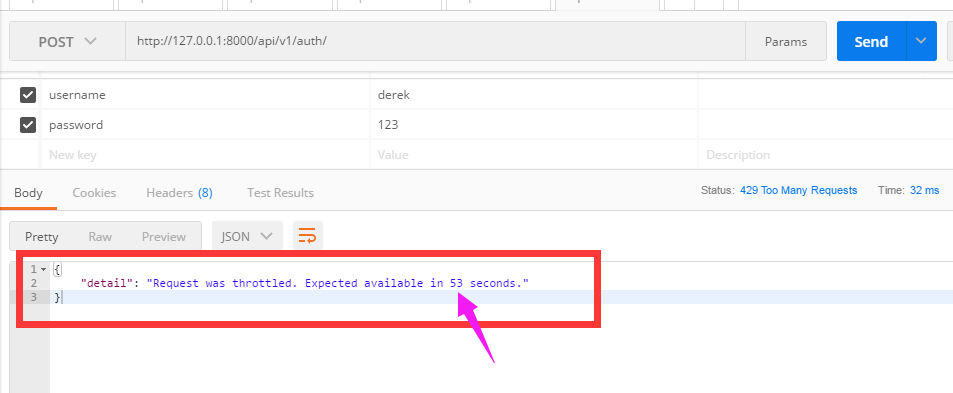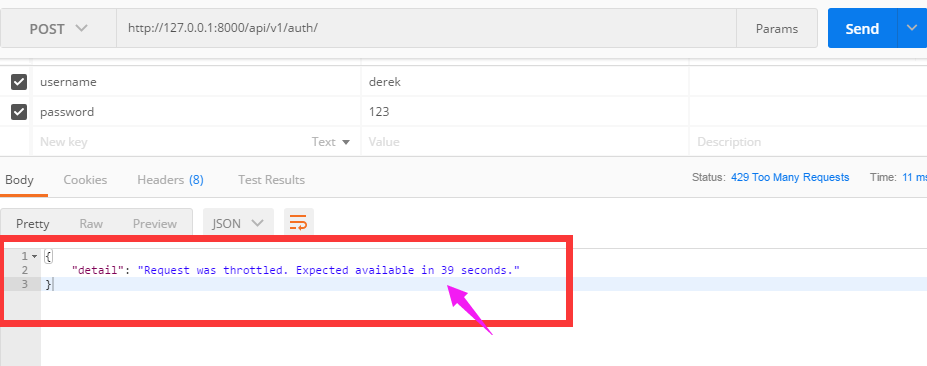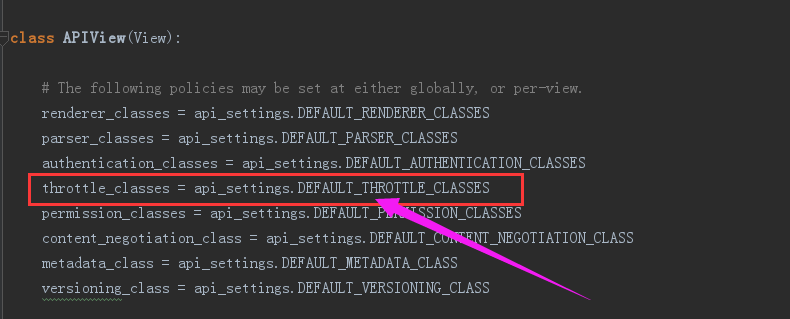Add throttling
Custom throttling method
- Limit access to 3 times within 60s
(1) Create a new throttle.py under the API folder. The code is as follows:
# utils/throttle.py from rest_framework.throttling import BaseThrottle import time VISIT_RECORD = {} #Save access records class VisitThrottle(BaseThrottle): '''60s Can only access 3 times in''' def __init__(self): self.history = None #Initialize access record def allow_request(self,request,view): #Get users ip (get_ident) remote_addr = self.get_ident(request) ctime = time.time() #If current IP Not in the access record, add to the record if remote_addr not in VISIT_RECORD: VISIT_RECORD[remote_addr] = [ctime,] #Save the form of key value pair return True #True Indicates accessible #Get current ip Historical access to history = VISIT_RECORD.get(remote_addr) #Initialize access record self.history = history #If there is historical access record, and the earliest access record is more than 60 from the current time s,Delete the earliest access record, #As long as True,I've been looping through the oldest access records while history and history[-1] < ctime - 60: history.pop() #If the access record does not exceed three times, insert the current access record to the first location( pop Delete last) if len(history) < 3: history.insert(0,ctime) return True def wait(self): '''How long will it take to visit''' ctime = time.time() return 60 - (ctime - self.history[-1])
(2) Global configuration throttling in settings
#Overall situation REST_FRAMEWORK = { #throttle "DEFAULT_THROTTLE_CLASSES":['API.utils.throttle.VisitThrottle'], }
(3) Now visit auth to see the results:
- If the number of visits exceeds three in 60 s, access will be restricted
- Prompt how much time is left to access

Next visit

Source code analysis of throttling
(1)dispatch
def dispatch(self, request, *args, **kwargs): """ `.dispatch()` is pretty much the same as Django's regular dispatch, but with extra hooks for startup, finalize, and exception handling. """ self.args = args self.kwargs = kwargs #Original request Processing, enriching some functions #Request( # request, # parsers=self.get_parsers(), # authenticators=self.get_authenticators(), # negotiator=self.get_content_negotiator(), # parser_context=parser_context # ) #request(Original request,[BasicAuthentications Object,]) #Getting native request,request._request #Get the object of the authentication class, request.authticators #1.encapsulation request request = self.initialize_request(request, *args, **kwargs) self.request = request self.headers = self.default_response_headers # deprecate? try: #2.Authentication self.initial(request, *args, **kwargs) # Get the appropriate handler method if request.method.lower() in self.http_method_names: handler = getattr(self, request.method.lower(), self.http_method_not_allowed) else: handler = self.http_method_not_allowed response = handler(request, *args, **kwargs) except Exception as exc: response = self.handle_exception(exc) self.response = self.finalize_response(request, response, *args, **kwargs) return self.response
(2)initial
def initial(self, request, *args, **kwargs): """ Runs anything that needs to occur prior to calling the method handler. """ self.format_kwarg = self.get_format_suffix(**kwargs) # Perform content negotiation and store the accepted info on the request neg = self.perform_content_negotiation(request) request.accepted_renderer, request.accepted_media_type = neg # Determine the API version, if versioning is in use. version, scheme = self.determine_version(request, *args, **kwargs) request.version, request.versioning_scheme = version, scheme # Ensure that the incoming request is permitted #4.Implementation authentication self.perform_authentication(request) #5.Authority judgement self.check_permissions(request) #6.Control access frequency self.check_throttles(request)
(3)check_throttles
There's a "allow me request" in it
def check_throttles(self, request): """ Check if request should be throttled. Raises an appropriate exception if the request is throttled. """ for throttle in self.get_throttles(): if not throttle.allow_request(request, self): self.throttled(request, throttle.wait())
(4)get_throttles
def get_throttles(self): """ Instantiates and returns the list of throttles that this view uses. """ return [throttle() for throttle in self.throttle_classes]
(5)thtottle_classes

Built in throttle class
Above is the custom throttling written. drf has many throttling classes built in, which is more convenient to use.
(1)BaseThrottle
- I want to write the allow? Request and wait methods
- Get? Ident is to get ip
class BaseThrottle(object): """ Rate throttling of requests. """ def allow_request(self, request, view): """ Return `True` if the request should be allowed, `False` otherwise. """ raise NotImplementedError('.allow_request() must be overridden') def get_ident(self, request): """ Identify the machine making the request by parsing HTTP_X_FORWARDED_FOR if present and number of proxies is > 0. If not use all of HTTP_X_FORWARDED_FOR if it is available, if not use REMOTE_ADDR. """ xff = request.META.get('HTTP_X_FORWARDED_FOR') remote_addr = request.META.get('REMOTE_ADDR') num_proxies = api_settings.NUM_PROXIES if num_proxies is not None: if num_proxies == 0 or xff is None: return remote_addr addrs = xff.split(',') client_addr = addrs[-min(num_proxies, len(addrs))] return client_addr.strip() return ''.join(xff.split()) if xff else remote_addr def wait(self): """ Optionally, return a recommended number of seconds to wait before the next request. """ return None
(2)SimpleRateThrottle
class SimpleRateThrottle(BaseThrottle): """ A simple cache implementation, that only requires `.get_cache_key()` to be overridden. The rate (requests / seconds) is set by a `rate` attribute on the View class. The attribute is a string of the form 'number_of_requests/period'. Period should be one of: ('s', 'sec', 'm', 'min', 'h', 'hour', 'd', 'day') Previous request information used for throttling is stored in the cache. """ cache = default_cache timer = time.time cache_format = 'throttle_%(scope)s_%(ident)s' scope = None #This value can be customized. You can write anything THROTTLE_RATES = api_settings.DEFAULT_THROTTLE_RATES def __init__(self): if not getattr(self, 'rate', None): self.rate = self.get_rate() self.num_requests, self.duration = self.parse_rate(self.rate) def get_cache_key(self, request, view): """ Should return a unique cache-key which can be used for throttling. Must be overridden. May return `None` if the request should not be throttled. """ raise NotImplementedError('.get_cache_key() must be overridden') def get_rate(self): """ Determine the string representation of the allowed request rate. """ if not getattr(self, 'scope', None): msg = ("You must set either `.scope` or `.rate` for '%s' throttle" % self.__class__.__name__) raise ImproperlyConfigured(msg) try: return self.THROTTLE_RATES[self.scope] except KeyError: msg = "No default throttle rate set for '%s' scope" % self.scope raise ImproperlyConfigured(msg) def parse_rate(self, rate): """ Given the request rate string, return a two tuple of: <allowed number of requests>, <period of time in seconds> """ if rate is None: return (None, None) num, period = rate.split('/') num_requests = int(num) duration = {'s': 1, 'm': 60, 'h': 3600, 'd': 86400}[period[0]] return (num_requests, duration) def allow_request(self, request, view): """ Implement the check to see if the request should be throttled. On success calls `throttle_success`. On failure calls `throttle_failure`. """ if self.rate is None: return True self.key = self.get_cache_key(request, view) if self.key is None: return True self.history = self.cache.get(self.key, []) self.now = self.timer() # Drop any requests from the history which have now passed the # throttle duration while self.history and self.history[-1] <= self.now - self.duration: self.history.pop() if len(self.history) >= self.num_requests: return self.throttle_failure() return self.throttle_success() def throttle_success(self): """ Inserts the current request's timestamp along with the key into the cache. """ self.history.insert(0, self.now) self.cache.set(self.key, self.history, self.duration) return True def throttle_failure(self): """ Called when a request to the API has failed due to throttling. """ return False def wait(self): """ Returns the recommended next request time in seconds. """ if self.history: remaining_duration = self.duration - (self.now - self.history[-1]) else: remaining_duration = self.duration available_requests = self.num_requests - len(self.history) + 1 if available_requests <= 0: return None return remaining_duration / float(available_requests)
We can implement throttling by inheriting the SimpleRateThrottle class. It will be simpler because SimpleRateThrottle has been written for us
(1)throttle.py
from rest_framework.throttling import SimpleRateThrottle class VisitThrottle(SimpleRateThrottle): '''Anonymous users 60 s Can only be accessed three times (according to ip)''' scope = 'NBA' #The value in this is defined by yourself, settings It is configured according to this value Rate def get_cache_key(self, request, view): #adopt ip Restrictor throttling return self.get_ident(request) class UserThrottle(SimpleRateThrottle): '''Login user 60 s Can visit 10 times''' scope = 'NBAUser' #The value in this is defined by yourself, settings It is configured according to this value Rate def get_cache_key(self, request, view): return request.user.username
(2)settings.py
#Overall situation REST_FRAMEWORK = { #throttle "DEFAULT_THROTTLE_CLASSES":['API.utils.throttle.UserThrottle'], #Global configuration, login user throttling limit (10/m) "DEFAULT_THROTTLE_RATES":{ 'NBA':'3/m', #User 3 not logged in/m,NBA Namely scope Defined values 'NBAUser':'10/m', #Login user 10/m,NBAUser Namely scope Defined values } }
(3)views.py
Local configuration method
class AuthView(APIView): . . . # The default throttle is the login user (10/m),AuthView There is no need to log in, and anonymous users' throttling is used here (3/m) throttle_classes = [VisitThrottle,]
.
.
views.py from django.shortcuts import render,HttpResponse from django.http import JsonResponse from rest_framework.views import APIView from API import models from rest_framework.request import Request from rest_framework import exceptions from rest_framework.authentication import BaseAuthentication from API.utils.permission import SVIPPremission,MyPremission from API.utils.throttle import VisitThrottle ORDER_DICT = { 1:{ 'name':'apple', 'price':15 }, 2:{ 'name':'dog', 'price':100 } } def md5(user): import hashlib import time #Current time, equivalent to generating a random string ctime = str(time.time()) m = hashlib.md5(bytes(user,encoding='utf-8')) m.update(bytes(ctime,encoding='utf-8')) return m.hexdigest() class AuthView(APIView): '''For user login authentication''' authentication_classes = [] #It is empty, which means no authentication is required permission_classes = [] #No, it's empty, which means you don't need permission # The default throttle is the login user (10/m),AuthView There is no need to log in, and anonymous users' throttling is used here (3/m) throttle_classes = [VisitThrottle,] def post(self,request,*args,**kwargs): ret = {'code':1000,'msg':None} try: user = request._request.POST.get('username') pwd = request._request.POST.get('password') obj = models.UserInfo.objects.filter(username=user,password=pwd).first() if not obj: ret['code'] = 1001 ret['msg'] = 'Wrong user name or password' #Create for user token token = md5(user) #Update if it exists, create if it doesn't exist models.UserToken.objects.update_or_create(user=obj,defaults={'token':token}) ret['token'] = token except Exception as e: ret['code'] = 1002 ret['msg'] = 'Request exception' return JsonResponse(ret) class OrderView(APIView): ''' //Order related business (only SVIP users can view it) ''' def get(self,request,*args,**kwargs): self.dispatch #request.user #request.auth ret = {'code':1000,'msg':None,'data':None} try: ret['data'] = ORDER_DICT except Exception as e: pass return JsonResponse(ret) class UserInfoView(APIView): ''' //Order related business (common users and VIP users can see it) ''' permission_classes = [MyPremission,] #Without global permission configuration, you need to write your own local permission here def get(self,request,*args,**kwargs): print(request.user) return HttpResponse('User information')
from django.shortcuts import render,HttpResponse from django.http import JsonResponse from rest_framework.views import APIView from API import models from rest_framework.request import Request from rest_framework import exceptions from rest_framework.authentication import BaseAuthentication from API.utils.permission import SVIPPremission,MyPremission from API.utils.throttle import VisitThrottle ORDER_DICT = { 1:{ 'name':'apple', 'price':15 }, 2:{ 'name':'dog', 'price':100 } } def md5(user): import hashlib import time #Current time, equivalent to generating a random string ctime = str(time.time()) m = hashlib.md5(bytes(user,encoding='utf-8')) m.update(bytes(ctime,encoding='utf-8')) return m.hexdigest() class AuthView(APIView): '''For user login authentication''' authentication_classes = [] #It is empty, which means no authentication is required permission_classes = [] #No, it's empty, which means you don't need permission # The default throttle is the login user (10/m),AuthView There is no need to log in, and anonymous users' throttling is used here (3/m) throttle_classes = [VisitThrottle,] def post(self,request,*args,**kwargs): ret = {'code':1000,'msg':None} try: user = request._request.POST.get('username') pwd = request._request.POST.get('password') obj = models.UserInfo.objects.filter(username=user,password=pwd).first() if not obj: ret['code'] = 1001 ret['msg'] = 'Wrong user name or password' #Create for user token token = md5(user) #Update if it exists, create if it doesn't exist models.UserToken.objects.update_or_create(user=obj,defaults={'token':token}) ret['token'] = token except Exception as e: ret['code'] = 1002 ret['msg'] = 'Request exception' return JsonResponse(ret) class OrderView(APIView): ''' //Order related business (only SVIP users can view it) ''' def get(self,request,*args,**kwargs): self.dispatch #request.user #request.auth ret = {'code':1000,'msg':None,'data':None} try: ret['data'] = ORDER_DICT except Exception as e: pass return JsonResponse(ret) class UserInfoView(APIView): ''' //Order related business (common users and VIP users can see it) ''' permission_classes = [MyPremission,] #Without global permission configuration, you need to write your own local permission here def get(self,request,*args,**kwargs): print(request.user) return HttpResponse('User information')
